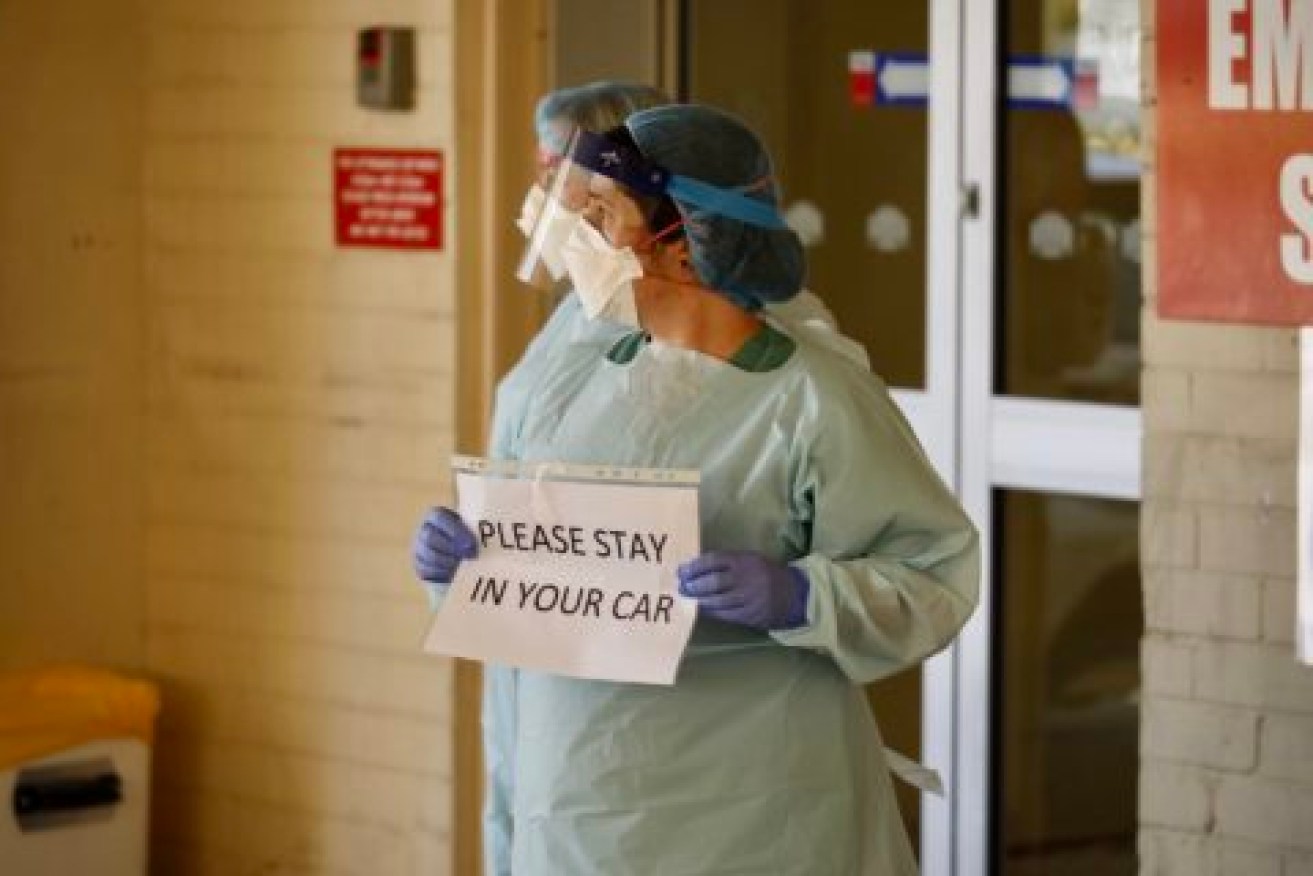SA’s COVID-19 performance – the expert analysis
As SA slowly lifts restrictions and passes two weeks with no new COVID-19 cases, questions are asked: why is this state in such a good position, and how did it avoid the outbreaks experienced elsewhere? InDaily called some experts.

Drive-through COVID-19 testing at the Repat hospital began in March. Photo: Tony Lewis/InDaily
When the COVID-19 pandemic took hold across the globe in January and February, Australian Medical Association SA president Chris Moy remembers being gripped by fear over the unprecedented nature of the situation.
“Nobody had been let down the slide before,” he said. “Everyone was scared – I was scared about whether my recommendations were right. It was a ridiculous, overwhelming amount of anxiety-inducing information, even for the decision makers.”
Several months on, with no active cases across the state and just four reported deaths despite some of the most relaxed restrictions in the country, it seems that Moy and other key decision-makers got their response largely right.
Leading medical experts contacted by InDaily agree, but note that it was as much a case of COVID-19 avoiding SA as it was of SA avoiding COVID-19, with the state enjoying a host of natural advantages compared to much of the world.
These include low-density living environments, lower levels of public transport use, and — most of all — lower numbers of international visitors compared to other Australian states.
Epidemiologist Professor John Kaldor, the head of the Public Health Interventions Research Group at UNSW’s Kirby Institute, mostly credits the suppression of the virus to the national response.
“The jurisdictions clearly have different histories of case numbers, but that was largely a result of the patterns of entry from overseas,” he said. “And with higher entry numbers to deal with, the probability of sustaining an outbreak event such as Ruby Princess or Cedar Meats was also elevated in those jurisdictions.”
Adrian Esterman, Professor of Biostatistics at the University of South Australia, credited the SA public for adhering to social distancing, but also noted that “we were lucky in that SA has comparatively few cruise liners turning up to infect us and doesn’t have a major international airport hub”.
Interstate cruise ships proved a threat in any case, with dozens of SA cases linked to exposure to passengers returning from the Ruby Princess after it arrived from Sydney.
This leads to another key element to the state’s suppression of COVID-19: the introduction of mandatory quarantine for interstate visitors from late March.
Stephen Duckett, the Health Program Director for the Grattan Institute, highlighted the border closure as a vital move, and noted it was more feasible for SA than states that never took that step.
“Victoria and NSW feature a number of conurbations on their border — multiple places along the Murray with towns spanning both sides with close links,” he said. “SA has a bit of that with Victoria, but not to the same extent.”
Duckett, a member of South Australia’s independent Health Performance Council, stresses that the state did excel in its response, noting that SA Health was in more regular contact with him than their interstate counterparts about using Grattan Institute data to track the spread of the virus across the country.
“They were on top of the issue early, closely monitoring it, so they saw where and when infections were rising,” he said.
In a statement, the Department for Health and Wellbeing’s Chief Public Health Officer, Professor Nicola Spurrier credited widespread testing as the key to suppressing the virus.
“Unlike other states, we began testing any South Australian with a respiratory illnesses for COVID-19 in early February,” she said.
Moy agrees, noting the early focus on testing explains why SA appeared to be one of the first to suppress the virus, yet sits mid-range in many of the key statistics tracking state-by-state performances.
Whereas Victoria is the current leader in the testing rate today, SA was the national leader at the end of April, when it had tested 3.2% of the population compared to NSW in second place with 2.6%.
Moy argues that high levels of testing when the virus was more prevalent boosted SA’s recorded infections, explaining why the state has the equal third-highest infection rate per capita in the country, equal or behind states still battling outbreaks such as Victoria, Queensland and WA.
Aside from testing, Moy argues the state’s public health bodies outperformed other states “in the small things”, including better communication with doctors through weekly webinars, and with the state’s population through public messaging.
“One example was in signage at medical clinics: the Victorian one was just hopeless,” he said. “It said that if you’re experiencing symptoms, please talk to a receptionist. That’s not on, you’d infect staff. So ours were placed out the front saying ‘please don’t enter the practice if you have symptoms, call in’ [on the phone]. Little things matter.”
A spokesperson for Victoria’s Department of Health and Human Services said that advice to GPs is regularly reviewed and updated, and that current advice is to call ahead.
Moy argued that the signage was an example of things that should have been taken care of at a federal level that individual states needed to take care of themselves. “We should have national supply chains ready to go for masks and stuff like that,” he said. “We shouldn’t have had to rely on SA getting it right.”
Back at the Grattan Institute, Duckett says that Australia as a whole has done “remarkably well”, but sounds a note of caution. “We’re not out of the woods yet, and could still have a second wave,” he said. “I would be cautious about saying we’re the best thing since sliced bread.”
Want to comment?
Send us an email, making it clear which story you’re commenting on and including your full name (required for publication) and phone number (only for verification purposes). Please put “Reader views” in the subject.
We’ll publish the best comments in a regular “Reader Views” post. Your comments can be brief, or we can accept up to 350 words, or thereabouts.
This article is supported by the Judith Neilson Institute for Journalism and Ideas.





